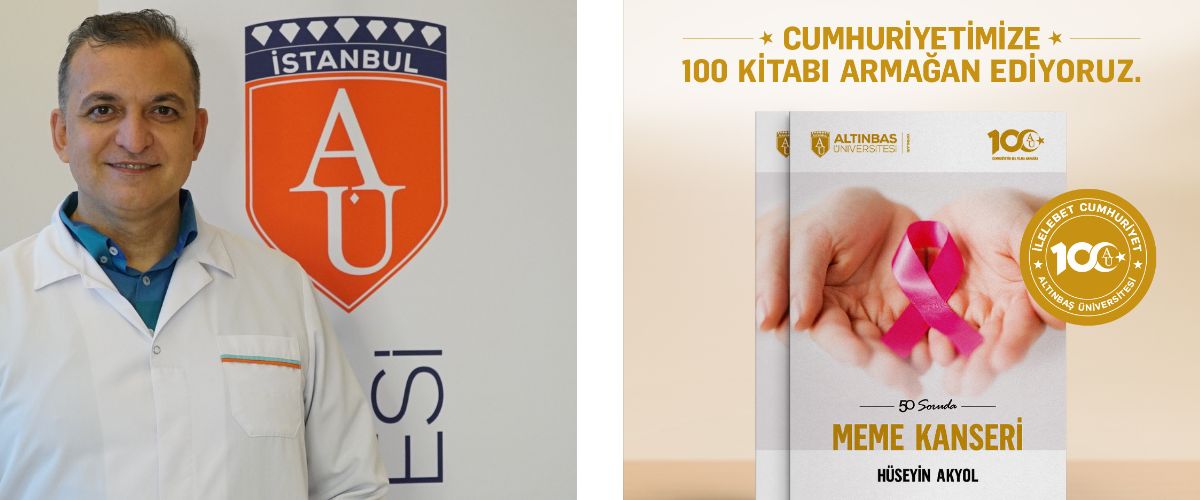Reducing Breast Cancer Risk is Possible!
Every year in October, special events are organized all over the world to raise awareness about breast cancer. In the Breast Cancer in 50 Questions book published by Altınbaş University Publications mentioned important issues.
Every year in October, special events are organized all over the world to raise awareness about breast cancer. Altınbaş University Faculty of Medicine Faculty Member, General Surgeon Dr. Hüseyin Akyol gives important information about the methods of reducing the risk of breast cancer in the book Breast Cancer in 50 Questions.
Pay Attention to 4 items!
Every year in October, special events are organized all over the world to raise awareness about breast cancer. In the book 50 Questions about Breast Cancer published by Altınbaş University Publications, important issues that need to be known about the subject are also mentioned. The book, written by Altınbaş University Faculty of Medicine Faculty Member, General Surgeon Dr. Hüseyin Akyol, states that many factors affect the risk of breast cancer throughout a lifetime and provides important information about methods to reduce this risk.
Dr. Hüseyin Akyol reminds that factors such as aging or family history cannot be changed. Stating that 99% of breast cancers occur in women, he points out that the risk increases with age. Underlining that most cancers develop after the age of 50, Dr. Akyol said, “The average age of developing breast cancer is 63. Those who have their first period before the age of 12 are twice as likely to develop breast cancer compared to those who have their first period after the age of 12. This risk increases as the duration of exposure to estrogen increases.”
“Late menopause increases the risk of breast cancer by 2 times”
Stating that entering menopause at an advanced age also increases the risk of breast cancer by 2 times, Dr. Akyol said, 'This risk is 2 times higher than women who enter menopause at the age of 45. Estrogen and progesterone production decreases with age and there is a sharp decline around menopause. Longer exposure to these hormones increases the risk of breast cancer.”
What are the factors that reduce the risk?
Dr. Akyol points out that despite all this, the risk of breast cancer can be reduced by paying attention to health. He expresses the opinion that creating an artificial menopause with bilateral ovarian surgery or irradiation of the uterus in connection with menopause will reduce the risk. First of all, she recommends keeping a healthy weight by exercising regularly and lists her other suggestions as follows:
* Do not consume alcoholic beverages.
* Eat a healthy diet. Follow a diet high in saturated fats and consisting of fruits and vegetables.
* Give birth before the age of 30. Pregnancy helps protect against breast cancer as it pushes breast cells into the final stage of maturation.
* Breastfeed your children.
Dr. Hüseyin Akyol also states that if there is a family history of breast cancer or hereditary changes in BRCA1 and BRCA genes, a physician should be consulted to reduce the risk. “Staying healthy throughout your life will reduce your risk of developing cancer and increase your chances of surviving cancer if it occurs,” he argues.
What are the symptoms of breast cancer and how is it diagnosed?
Stating that there may be different symptoms depending on the structure of the person, Dr. Akyol lists the main symptoms as follows;
- Palpation of a mass in the breast or armpit. This mass is usually painless.
- Thickening or swelling of the breast skin
- Inward pulling of the breast skin
- Redness or flaking of the skin on the nipple
- Pain or retraction in the nipple area
- Blood coming from the nipple
- Change in breast size or shape.
KKMM is very important in early diagnosis!
Pointing out that these symptoms may also indicate the presence of metastases, Dr. Hüseyin Akyol explains that breast cancer is diagnosed by clinical examination, imaging and biopsy. He emphasizes that early diagnosis of breast cancer increases the chances of treatment and survival. After the age of 20, he recommends that every woman should check themselves every month with Breast Self Examination (KKMM), and after the age of 40, they should have mammography screening every 2 years.
How is KKMM performed?
Finally, Dr. Hüseyin Akyol from Altınbaş University explains the step-by-step steps to perform KKMM, which is simple but saves lives with early diagnosis.
Step 1: The patient stands in front of a mirror. With shoulders straight and arms at the side, she checks her breasts in the mirror. She continues the visual inspection by placing her arms on her lower back. Both breasts should be symmetrical in this position. The size, shape and skin color of the breasts should be checked. Any pitting, shrinkage or swelling of the skin should be observed. The skin should be carefully examined for redness, a nipple that has changed position or a nipple that is inverted.
Step 2: The patient should check for the same changes with arms raised. It should be checked whether both breasts move symmetrically upwards with the arms raised. In this position, any pulling of the breast is important.
Step 3: While in front of the mirror, the nipples should be checked for fluid coming from the nipples. This fluid may be watery, milky or bloody.
Step 4: While lying down, the patient checks the left breast with the right hand and then the right breast with the left hand. The entire breast and armpits are assessed by making small circular movements with the three middle fingers of the hand.
Step 5: Finally, the breasts should be examined while standing or sitting. This can be done during a shower.


